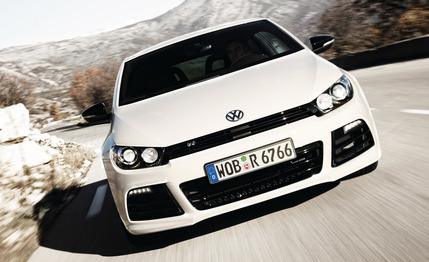
 First Drive Review
First Drive Review
Born into the oil crisis of the early 1970s and based on the compact Volkswagen Golf platform, the first-generation Scirocco was an efficient and sporty answer to the many domestic two-door coupes in the U.S. VW followed it up with a slightly bigger, second-gen car—as well as the Corrado, the Scirocco’s spiritual successor. But the company’s sports-car ambitions ultimately died with the Corrado in the 1990s.
However, the Scirocco is back—in Europe. VW doesn’t believe the U.S. market can support both the new car and the GTI (which is mechanically similar) without one cannibalizing the sales of the other. However, we can’t help feeling deprived of one of the hottest hot hatches on the market: the 265-hp Scirocco R, which we recently had a chance to put through its paces in the mountains near Nice, France.
Turbo Hotness
We like the sleek, unusual shape of the Scirocco—essentially, it’s a two-door “shooting brake” in the tradition of the Volvo 1800ES and Reliant Scimitar—the basic architecture of which is shared with the Golf, as well as the Audi A3, TT, and several other Volkswagen Group cars. VW fitted the 265-hp, direct-injected, 2.0-liter turbo four from the Audi S3 in the still-front-wheel-drive R model, which was inspired by the GT24 Nürburgring race car. “We could have made it even more powerful, but we wanted to achieve affordability,” says VW spokesman Martin Hube. In fact, the Scirocco R is the least expensive of the Volkswagen brand’s “R” models, which include the 270-hp, all-wheel-drive Golf R, as well as the European-market Passat R36 and Touareg R50. (The Seat Leon Cupra R, which is mechanically similar to the Scirocco R, undercuts the VW by about $5K in Europe.)
Some marketing types were concerned that customers would prefer a V-6 engine for cylinder-count bragging rights, but VW CEO Martin Winterkorn’s engine-downsizing strategy seems to be right on target. The Scirocco R’s turbo serves up 17 psi of boost, which makes available the engine’s 258 lb-ft of torque from 2500 to 5000 rpm. VW claims 62 mph comes in six seconds flat, and top speed is governed at 155 mph. The R gets an impressive 29 mpg in the combined European cycle with the available Direct Shift Gearbox. Stefan Ellrott, development chief at Volkswagen Individual, says he had the engineers tune the R’s soundtrack—“not too high-pitched, not too dark”—and the result is impressive. This four-banger sounds so sporty and powerful that we never wished for an extra couple of cylinders.
Although a six-speed manual transmission is standard, most buyers will opt for VW’s six-speed DSG automated manual. We’ve driven it in numerous VW and Audi vehicles, and despite being less fine-tuned than Porsche’s seven-speed PDK, it’s one of the best dual-clutch gearboxes available. We do, however, applaud VW for still offering a proper manual.
Front Drive = Less Weight
The front wheels cope with that much power and torque surprisingly well. Torque steer is minimal, and the R’s electronic front differential keeps the car from leaping into the shrubbery on corner exit without hindering steering accuracy. Of course, a rear-biased all-wheel-drive system would be more fun, but that adds weight, cost, and additional drivetrain losses.
The Scirocco R is claimed to be more than 200 pounds lighter than the all-wheel-drive Golf R. The Scirocco R’s chassis also is up to the task of taming the 2.0T’s power. The disc brakes—13.6 inches in front, 12.2 inches at the rear—are hefty and effective. The super-sensitive electromechanical power steering weights up nicely with a push of the sport button on the console and offers good feedback—there is little of the artificial feel often associated with electric power steering. The GTI’s flat-bottom steering wheel is a nice touch, too.
Visually Arresting
Eighteen-inch wheels are standard, but the 19-inch Talladega wheels wrapped in Bridgestone Potenza rubber look better and offer impressive grip. Other design cues that differentiate the R from lesser Sciroccos include oversize air intakes, LED daytime running lights, darkened taillights, wide rocker panels, and two chrome exhaust pipes framing a black diffuser. Also featured are angular but supportive sport seats and blue needles on the instrumentation—a trademark of VW’s R models—as well as brushed-aluminum trim and pedals and headrests embroidered with the “R” logo.
Unfortunately for VW, some of the Scirocco R’s closest competitors come from within the VW Group: namely, the Golf R and the Audi TTS, both of which sport all-wheel drive. But the Scirocco R is the least expensive—about 10 percent less than the Golf R, or about 25 percent more than the GTI. It’s also the most brutal of the bunch, but it’s sure to bring many smiles to its driver’s face. It did to ours. We’d now like to file another complaint with VW about the decision not to bring it here.